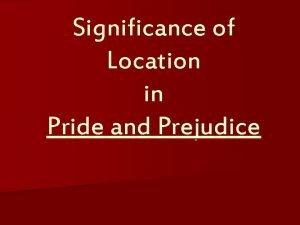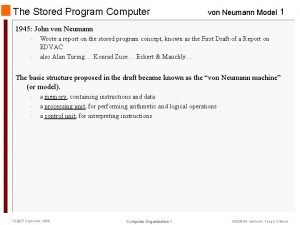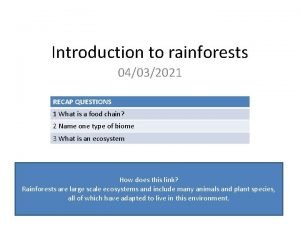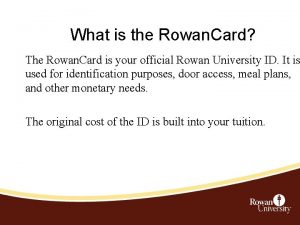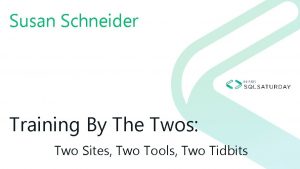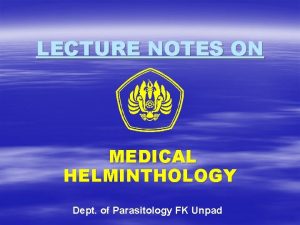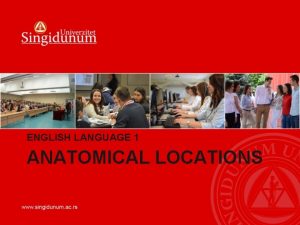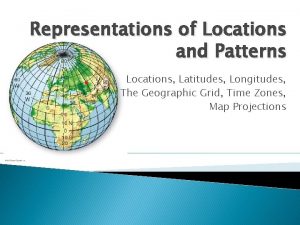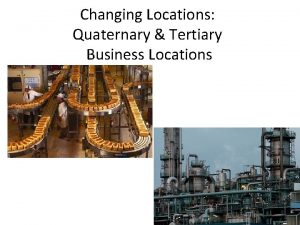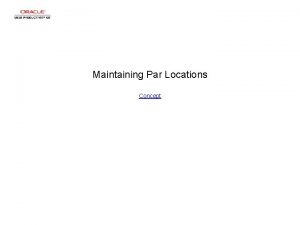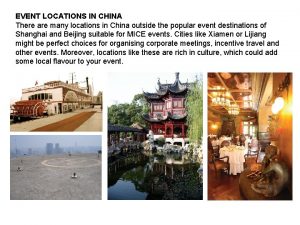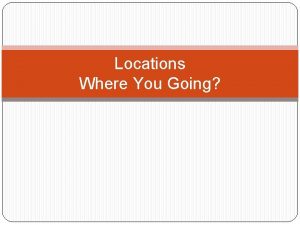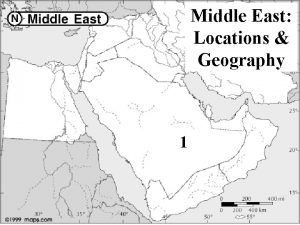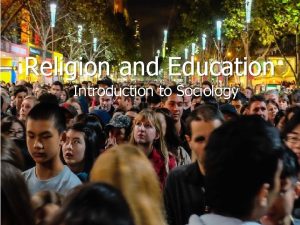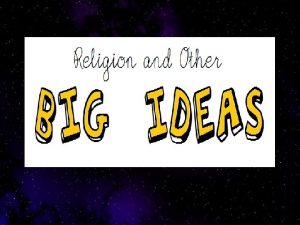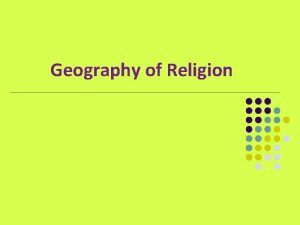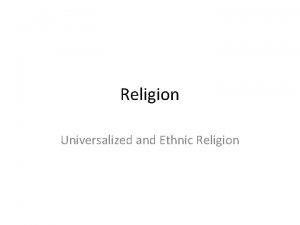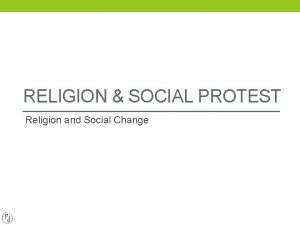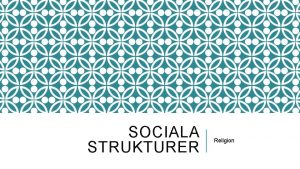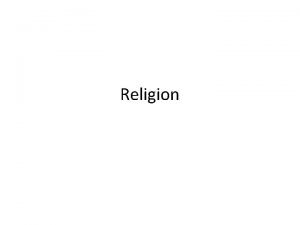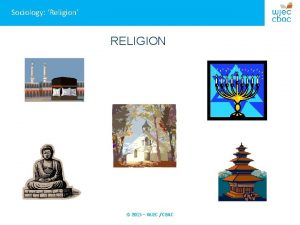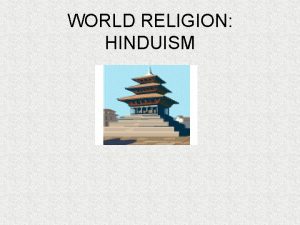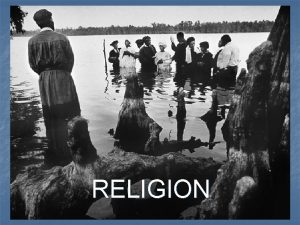Introduction to Religion Types and Locations Religion language











































- Slides: 43

Introduction to Religion Types and Locations

• Religion & language are the foundations of culture – confer & reflect identity • Spreads through diffusion • Cultural landscape: – Churches, mosques, cemeteries, shrines, statues, symbols – Presence or absence of: liquor stores, depiction of human form – Dress – turbans, veils, beards

Examples of diffusion of religion • Missionaries (Christianity in Africa, South America and South East Asia. ) • Conquest • Hierarchical (Constantine) • Conversion (England? ) • Forced conversion (Christianity Central and South America) • Books, teaching (radio, television) • Migration, pilgrims (US)

Globalization vs. Local Diversity • • • Core values and beliefs that define culture Universalizing vs. ethnic religion Impact on the landscape Adoption = turning away from ethnic religion Migrants learn a new language but not a new religion

Jews Hindus Sikhs Japanese Shintoists and Buddhists Unpopulated Protestants Muslims (Sunni) Indigenous Religions Roman Catholics Orthodox Christians Muslims (Shiite) Mormons Churches of Eastern Christianity Buddhists Christians from various churches No dominant religion/non -religious On scrap piece of paper, number 1 -16. 1 2 3 9 10 11 4 5 12 13 14 15 6 7 8 16 Try to match each of the colors (#s) to the religions found in the word bank above.

Geographers distinguish two kinds of religions… 1. Universalizing Religions – attempt to be global, to appeal to all people wherever they may be in the world, not just to those of one culture or location. 2. Ethnic Religions – Appeals primarily to one group of people living in one place. ü About 60% of the worlds people belong to a universalizing religion, 25% to an ethnic religion, and 15% to no religion at all.

How do Universalizing and Ethnic Religions Differ? Universalizing • Appeal to people everywhere. • Individual founder (prophet). • Message diffused widely (missionaries). • Followers distributed widely. • Holidays based on events in founder’s or other inportant figure’s life. Ethnic • Has meaning in particular place(s) only. • Unknown source. • Content focused on place and landscape of origin. • Followers highly clustered. • Holidays based on local climate and agricultural practice.

Early Religious Practice • • Animism Polytheism Monotheism Most of history polytheism and animism were predominant

Animism (Shamanism) - the belief that all objects, animals, and beings are “animated” or possess a spirit and a conscious life. Also called shamanism because of the prominence of a Shaman. • Such beliefs were common among hunter- gatherers. • Greatest concentration of animistic believers today is in Sub-Saharan Africa • These beliefs are losing ground to Christianity and Islam throughout Africa. Nigerian Shaman

Universalizing Religions

UNIVERSALIZING RELIGIONS • 3 main universalizing religions: Christianity, Islam, and Buddhism. – Lesser Known: • Sikhism • Baha’i • Each are divided into branches, denominations, and sects. Ø Branch – large and fundamental division within a religion Ø Denomination – a division of a branch that unites a number of local congregations in a single legal and administrative board. Ø Sect – a relatively small group that has broken away from an established denomination.

World Distribution of Religions Fig. 6 -1: World religions by continent.

World Population by Religion Fig. 6 -1 a: Over two thirds of the world’s population adhere to Christianity, Islam, Hinduism, or Buddhism. Christianity is the single largest world religion.

Diffusion of Universalizing Religions Fig. 6 -4: Each of the three main universalizing religions diffused widely from its hearth.

http: //www. mapsofwar. com/ind/historyof-religion. html

Christianity • • • Largest – 2 billion, most widespread Founded on teachings of Jesus of Nazareth Named the “Christ” Greek from Hebrew messiah = anointed Taught for 3 years; betrayed by Judas, tried and crucified Relocation- 1 st diffused through missionaries – Paul of Tarsus (relocation) then contagious daily contact between believers and Pagans • Hierarchical – Constantine & Theodosius, conversion of Kings in Eastern Europe • Most prevalent in North America, South America, Europe and Australia • 3 branches – Roman Catholic, Protestant, Eastern Orthodox

ur

Roman Catholic • 52% of Christians • Pope is the head of the church • Dominant in Europe and Latin America • Power peaked in Middle Ages • Smaller numbers living in south of Netherlands and Switzerland • Sacraments: Baptism, Confirmation, Penance, Anointing the sick, Matrimony, Holy Orders and Eucharist • Transubstantiation

Roman Catholic Hierarchy in U. S.

Eastern Orthodox • • • Pope vs. Patriarch 1054 (break in 1400 s) Accept 7 sacraments, reject anything added since the 8 th century 14 Self Governing Churches Eastern Europe, Russia (40%), Middle East – Romanian (20%), Bulgarian, Greek, Serbian (10% each) Oldest: (3%) – Constantinople, Alexandria, Antioch, Jerusalem Newer: (2%) – Albania, Cyprus, Georgia, Poland, Sinai

Protestant • 1517 Martin Luther • Personal salvation through a direct relationship • Grace through faith rather than sacraments Europe • Lutheran – Germany, Sweden • Anglican – England, Northern Ireland • Presbyterian - Scotland Western Hemisphere • 90% Christian • 28% of US protestant • 35 million Baptists – mostly in the south • Methodist, Pentecostal, Lutheran – mostly in upper mid-west


Christian Branches in the U. S.

Christian Branches in Europe


Smaller Branches • Coptic Church of Egypt • Ethiopian church 1948 split from Coptic • Armenian – conflict in Azerbaijan – Nagorno -Karabakh • Maronites – Lebanon • Mormons (3%)

Islam • 1. 3 billion people • Mostly in Middle East • Traces origin to Judaism and Christianity; Jews & Christians trace story through original wife Sarah and son Isaac; Muslims through 2 nd wife Hagar and son Ishmael – settle in Mecca • Muhammad born in Makkah 570 CE • Angel Gabriel speaks to him = Quran; Arabic • By his death diffused through most of Saudi Arabia • Islam = submission to the will of God (Allah) • 5 Pillars: no God but one, pray 5 times daily, alms to the poor, fasts during Ramadan, Pilgrimage to Mecca • Diffusion – armies conquered much of the Middle East and India; relocation then contagious diffusion; Indonesia Arab traders – relocation diffusion • Calendar – lunar; 19 yrs of 354 days 11 years 355 days; holidays are in different seasons; Ramadan moves

Divisions in Islam Shia/Shiite Sunni • 16% • 30% in Iran, 15% Pakistan, 10% Iraq • 90% of pop in Iran, over ½ in Azerbaijan, Iraq, Oman Bahrain • Shah (king) vs. Ayatollah (religious scholar) • Imams – sanctioned by Allah and infallible • 83% • Largest branch, mostly middle east and Asia • Believed the caliphate did not have to be hereditary • Family and community

Other Sects • Wahhabis, Sufis, Salafists, Alawites, Alevis, Yazeedis, Ahmadiya • 5 million Muslims in US and Canada • North America – Nation of Islam – – Elijah Muhammad Black Muslims Organization of Afro-American unity – Malcolm X Various names now – American Society of Muslims

Diffusion of Islam Fig. 6 -6: Islam diffused rapidly and widely from its area of origin in Arabia. It eventually stretched from southeast Asia to West Africa.

Mecca, Islam’s Holiest City Fig. 6 -10: Makkah (Mecca) is the holiest city in Islam and the site of pilgrimage for millions of Muslims each year. There are numerous holy sites in the city.

Makkah during the Hajj Pilgrimage The Ka’ba stands at the center of the Great Mosque (al-Haran al Sharif) in Makkah.

Buddhism • 400 million worldwide, mostly in China and SE Asia • Siddhartha Gautama – 6 years of meditation; becomes “Buddha” or enlightened one • 4 Noble Truths – Living beings endure suffering – Reincarnation – suffering – Escape from suffering and reach Nirvana – Eightfold path, rightness of belief, resolve, speech, action, livelihood, effort, thought and meditation • 3 branches – “Mahayana” – large raft – emphasis on teaching and helping others (56% - China, Japan, Korea), Theravada – oldest means way of the elders, must become a monk (38% Cambodia, Laos, Thailand, Myanmar, Sri Lanka), Tantrayana (6% Tibet, Mongolia)

Ü Buddhism – a religious doctrine introduced in northern India in the 6 th century B. C. by Siddhartha Gautama, known as the Buddha, or “Enlightened One” Ü Letting go of physical possessions allows one to gain wisdom and wisdom is the key to achieving nirvana


Ü Siddhartha Gautama – A wealthy young prince who grew to be unhappy with his life of luxury and after many attempts reached enlightenment through meditation (not a god)

Ü The Four Noble Truths – the four central beliefs containing the essence of Buddhist teaching:

Ü The Eightfold Path (Middle Path) – the path to nirvana, comprising eight aspects in which an follower must become practiced: right views, intention, speech, action, livelihood, effort, mindfulness, and concentration

Ü stupas – a dome-shaped structure erected as a Buddhist shrine.

Statue of Buddha Hong Kong, China Holy Places: 8 shrines – Lumbini – southern Nepal birthplace of Buddha Temple at Bodh Gaya – where Buddha reached perfect wisdom Bodhi tree is holy = enlightenment Deer Park in Sarnath - 1 st sermon Dhamek pagoda in Sarnath oldest structure in India Kusinagara – Buddha died Sravasti – greatest miracle Samkasya- ascended to heaven Rajagrha tamed a wild elephant; 1 st buddhist council Vaisali – announcement of impending death and 2 nd council

Holy Sites in Buddhism Fig. 6 -9: Most holy sites in Buddhism are locations of important events in Buddha’s life and are clustered in northeastern India and southern Nepal.

Buddhist Temple Bodh Gaya, India

Other Universalizing Religions • Sikhism – 25 million (1600’s) – Many live in Punjab region of India – Believe in one supreme being – Guru is the head – Amrit – baptism – Turbans – sense of unity • Baha’i-8 million (mid 1800’s) – Babi – Iran – Overcome the disunity of religions – Establish a universal faith through abolition of racial, class and religious prejudices
 Secneer
Secneer Locations in pride and prejudice
Locations in pride and prejudice How do you save panel locations and visibility preferences?
How do you save panel locations and visibility preferences? Tropical wet and dry locations
Tropical wet and dry locations Neumann dst
Neumann dst Ncdmv license and theft bureau
Ncdmv license and theft bureau Pulse points on body
Pulse points on body Vcc locations
Vcc locations Ocean tides observed at coastal locations
Ocean tides observed at coastal locations Amt chapter locations
Amt chapter locations Duality memory
Duality memory Desert biome climate
Desert biome climate Registry autostart locations
Registry autostart locations Brachial pulse
Brachial pulse Navfac southwest organizational chart
Navfac southwest organizational chart Goat lymph node locations
Goat lymph node locations Iv locations in arm
Iv locations in arm Iv sites on foot
Iv sites on foot Desert operations ba
Desert operations ba Highway patrol episode fake cop
Highway patrol episode fake cop Locations of grasslands
Locations of grasslands Root dns servers locations
Root dns servers locations Iv locations in arm
Iv locations in arm Layered tetrahedrons ansys
Layered tetrahedrons ansys The locations of seismic belts are determined by plotting
The locations of seismic belts are determined by plotting Creeping obesity
Creeping obesity 5 heart sound locations
5 heart sound locations Decal koala fingerprint locations
Decal koala fingerprint locations What two locations are marine ecosystems usually located
What two locations are marine ecosystems usually located Air force types
Air force types Card services sdsu
Card services sdsu Awg kenosha wi
Awg kenosha wi Pine environmental canada inc
Pine environmental canada inc Rainforest locations
Rainforest locations Rainforests of the world map
Rainforests of the world map Unplanned retail locations
Unplanned retail locations Hobo dough
Hobo dough Location of murmurs
Location of murmurs How to check rowan bucks balance
How to check rowan bucks balance Map of great gatsby setting
Map of great gatsby setting Schneider training locations
Schneider training locations Maryland bar application deadline
Maryland bar application deadline General parasitology lecture notes
General parasitology lecture notes Mobility express locations
Mobility express locations

